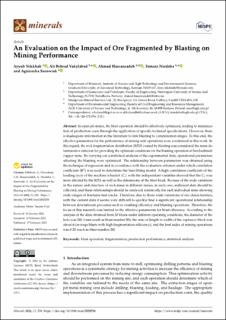| dc.description.abstract | In open-pit mines, the blast operation should be effectively optimized, leading to minimization of production costs through the application of specific technical specifications. However, there is inadequate information in the literature to link blasting to comminution stages. To this end, the effective parameters for the performance of mining unit operations were scrutinized in this work. In this regard, the rock fragmentation distribution (RFD) caused by blasting was considered the main determinative criterion for providing the optimum conditions for the blasting operation at Sarcheshmeh copper mine. By carrying out a statistical analysis of the experimental data, operational parameters affecting the blasting were optimized. The relationship between parameters was obtained using the technique of regression and in accordance with the evaluation criterion under which correlation coefficient (R2) was used to determine the best fitting model. A high correlation coefficient of the loading cycle of the machine’s bucket (Cl) with the independent variables showed that the C1 was more affected by the RFD, as well as the dimensions of the blast block. Because of the wide variations in the nature and structure of rock mass in different mines, in each case, sufficient data should be collected, and these relationships should be analyzed statistically for each individual mine showing wide ranges of fractures and cracks. Therefore, due to these wide variations of ore characteristics, with the current data it seems very difficult to quickly find a significant operational relationship between downstream processes such as crushing efficiency and blasting operations. Therefore, the focus of this research was limited to the effective parameters for blast efficiency. According to the analysis of the data obtained from 20 blasts under different operating conditions, the diameter of the hole was 241.3 mm (such as blast number 20), the ratio of length to width of the explosive block was about 6 (average blasts with high fragmentation efficiency), and the best index of mining operations was 0.22 (such as blast number 20). | en_US |

